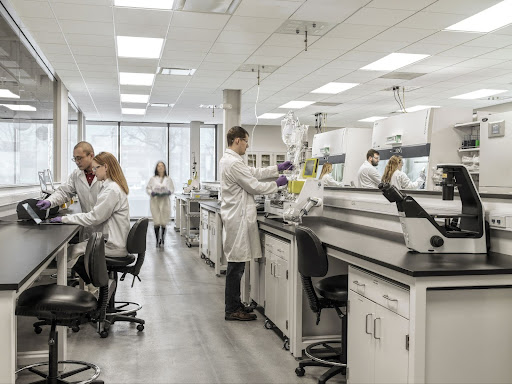Laboratories provide students and scientists with safe, functional, and comfortable spaces in which to perform cutting-edge research. Well-designed labs also include innovative features and stunning architectural details that attract and inspire researchers. Here are some of the challenges, opportunities, and key considerations in laboratory design.
Ergonomics

Many researchers spend a significant amount of time in the lab, and ergonomic components designed to improve the workspace also aim to enhance productivity and efficiency. Examples of ergonomic features in laboratories include power and gasses that are easier to access, adjustable furniture and storage cabinet windows with improved visibility. The award-winning California Air Resources Board lab, for example, has all its offices less than 15 seconds by foot from their corresponding labs. The goal is to reduce stress and increase efficiency.
Safety
Safety is one of the main concerns in laboratory environments. However, safety measures go beyond simply wearing personal protective equipment to include thoughtful lab design that minimizes hazards. For example, laboratories require enough space to store chemicals and flammable substances at safe distances apart. Chemicals should also be kept in storage areas that are easy to reach so scientists don’t have to reach for them up high cabinets or shelves.
Environmental Impact
Today’s laboratories should be designed with energy consumption and environmental impact in mind. One way to accomplish sustainability goals is to incorporate energy-efficient and smart fume hoods or filtered hoods in the lab design. Another is to build net-zero energy labs that aim to generate more energy than they use.
The Malcolm X School of Health Sciences at City Colleges of Chicago implemented many sustainable features in the design, including landscaped space with rainwater gardens and student courtyard. The project earned LEED Gold certification and is a great example of a project that is not only better for the environment but also is easier and less expensive to operate.
Versatility
Laboratories should have the flexibility to grow, evolve, and adapt to changing demands and technologies. If technicians need to reconfigure them to improve efficiencies or accommodate different workflows, their core design and features should make that easy. The laboratories at Eastern Kentucky University Sciences Building, for example, have mobile workbenches, lab furniture, and overhead service carriers. The sinks and fume hoods are positioned around the perimeter, allowing for easy reconfiguration as needed.
Connective Spaces
The University of Pennsylvania Vagelos Laboratory for Energy Science and Technology will have space options inside and outside the laboratory to encourage collaboration and discovery, as well as ample windows and daylighting to provide natural light and maximize visibility. This design element serves as a communal space, a connective corridor for accessing offices and labs, and a storage and delivery space for supplies and shipments.
Laboratory designs should reflect progress, problem-solving, and technological advances. The challenge is creating a space that’s comfortable, functional, sustainable, and safe. Contact the team at HERA laboratory planners to learn how they can help create an innovative learning and experimentation space.